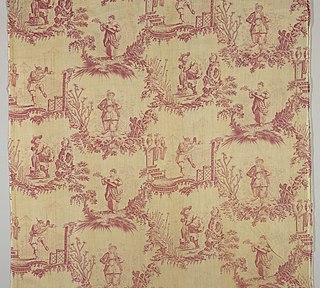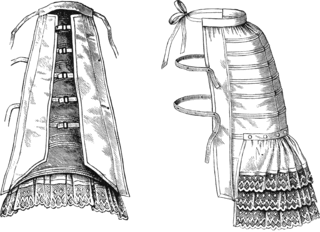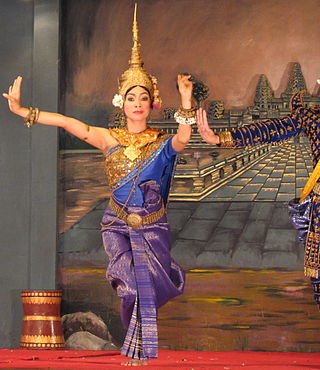Related Research Articles

Denim is a sturdy cotton warp-faced textile in which the weft passes under two or more warp threads. This twill weave produces a diagonal ribbing that distinguishes it from cotton duck. Denim, as it is recognized today, was first produced in Nîmes, France.

Serge is a type of twill fabric that has diagonal lines or ridges on both inner and outer surfaces via a two-up, two-down weave. The worsted variety is used in making military uniforms, suits, greatcoats, and trench coats. Its counterpart, silk serge, is used for linings. French serge is a softer, finer variety. The word is also used for a high-quality woven woolen fabric.

Dyeing is the application of dyes or pigments on textile materials such as fibers, yarns, and fabrics with the goal of achieving color with desired color fastness. Dyeing is normally done in a special solution containing dyes and particular chemical material. Dye molecules are fixed to the fiber by absorption, diffusion, or bonding with temperature and time being key controlling factors. The bond between the dye molecule and fiber may be strong or weak, depending on the dye used. Dyeing and printing are different applications; in printing, color is applied to a localized area with desired patterns. In dyeing, it is applied to the entire textile.

A pea coat is an outer coat, generally of a navy-coloured heavy wool, originally worn by sailors of European and later American navies. Pea coats are characterized by short length, broad lapels, double-breasted fronts, often large wooden, metal or plastic buttons, three or four in two rows, and vertical or slash pockets. References to the pea jacket appear in American newspapers at least as early as the 1720s, and modern renditions still maintain the original design and composition.

Double cloth or double weave is a kind of woven textile in which two or more sets of warps and one or more sets of weft or filling yarns are interconnected to form a two-layered cloth. The movement of threads between the layers allows complex patterns and surface textures to be created.

Harris tweed is a tweed cloth that is handwoven by islanders at their homes in the Outer Hebrides of Scotland, finished in the Outer Hebrides, and made from pure virgin wool dyed and spun in the Outer Hebrides. This definition, quality standards and protection of the Harris tweed name are enshrined in the Harris Tweed Act 1993.

Percale is a closely woven plain-weave fabric often used for bed covers. Percale has a thread count of about 140 or higher and is noticeably tighter than twill or sateen. It has medium weight, is firm and smooth with no gloss, and washes very well. It is made from both carded and combed yarns, and may be woven of various fibers, such as cotton, polyester, or various blends.

Taffeta is a crisp, smooth, plain woven fabric made from silk, nylon, cuprammonium rayons, acetate, or polyester. The word came into Middle English via Old French and Old Italian, which borrowed the Persian word tāfta (تافته), which means "silk" or "linen cloth". As clothing, it is used in ball gowns, wedding dresses, and corsets, and in interior decoration for curtains or wallcovering. It tends to yield a stiff, starched-like cloth that holds its shape better than many other fabrics and does not sag or drape.

Dimity is a collective term for figured cloths of harness loom decorated with designs and patterns. It is a strong cotton cloth with various stripes and illustrations. It is bleached or washed after looming, less often dyed, unlike fustian, which is usually dyed.

Tweed is a rough, woollen fabric, of a soft, open, flexible texture, resembling cheviot or homespun, but more closely woven. It is usually woven with a plain weave, twill or herringbone structure. Colour effects in the yarn may be obtained by mixing dyed wool before it is spun.

Red coat, also referred to as redcoat or scarlet tunic, is a military garment formerly much used by British infantrymen, so customarily that the term became a common synecdoche for the soldiers themselves.

Broadcloth is a dense, plain woven cloth, historically made of wool. The defining characteristic of broadcloth is not its finished width but the fact that it was woven much wider and then heavily milled in order to shrink it to the required width. The effect of the milling process is to draw the yarns much closer together than could be achieved in the loom and allow the individual fibres of the wool to bind together in a felting process, which results in a dense, blind face cloth with a stiff drape which is highly weather-resistant, hard wearing and capable of taking a cut edge without the need for being hemmed.
The manufacture of textiles is one of the oldest of human technologies. To make textiles, the first requirement is a source of fiber from which a yarn can be made, primarily by spinning. The yarn is processed by knitting or weaving, which turns yarn into cloth. The machine used for weaving is the loom. For decoration, the process of colouring yarn or the finished material is dyeing. For more information of the various steps, see textile manufacturing.

A sampot, a long, rectangular cloth worn around the lower body, is a traditional dress in Cambodia. It can be draped and folded in several different ways. The traditional dress is similar to the dhoti of Southern Asia. It is also worn in the neighboring countries of Laos and Thailand where it is known as pha nung.

Wool barathea evening waistcoat with silk collar and lining]]

Herringbone, also called broken twill weave, describes a distinctive V-shaped weaving pattern usually found in twill fabric. It is distinguished from a plain chevron by the break at reversal, which makes it resemble a broken zigzag. The pattern is called herringbone because it resembles the skeleton of a herring fish. Herringbone-patterned fabric is usually wool, and is one of the most popular cloths used for suits and outerwear. Tweed cloth is often woven with a herringbone pattern.

Oilcloth, also known as enameled cloth or American cloth, is close-woven cotton duck or linen cloth with a coating of boiled linseed oil to make it waterproof.
Ardfinnan Woollen Mills was a former wool mill, trading under messrs Mulcahy-Redmond and Co. Ltd. and located in the Suir Valley at the village of Ardfinnan, County Tipperary, Ireland. Founded in 1869, it manufactured woollen and worsted cloth, specialising in tweed and suitings for the tailoring trade. It briefly produced a unique weatherproof cloth, while later in its history turning to off-the-peg suits it became noted as the only firm in the Republic of Ireland completing all processes of clothing manufacture. A leading industry in Irish textiles, it closed in 1973 with the loss of over 100 employees.
Silesia was a thin twilled woven cloth made of linen or cotton. The term denoted a wide range of fabric grades from greige goods to dyed and finished cloth. Silesia was used for various linens, for lining clothes, and in window blinds. Cotton Silesia was calendered to obtain a gloss finish.
Salu is a type of twill cloth, woven from cotton and dyed red, originally made in India. Prior to the introduction of modern industrial techniques, it was produced exclusively hand spun (khaddar) yarns with locally-available dyes. Salu is one of seven cotton cloths explicitly mentioned in the 16th century Mughal record Ain-i-Akbari, together with khasa, tansukh, doriya, bafta, dupatta, and panchtoliya.
References
- ↑ J.H. Cutler, tailors, Sydney, Australia, "Bespoke Tailoring Glossary of Terms"
- ↑ "Fabric Glossary - Cloak & Dagger Creations". Cloakmaker.com. Retrieved 2016-01-18.
- ↑ "Donkey Jackets. £54. Quality Donkey Jacket, Work Coats". Bennevisclothing.com. Retrieved 2016-01-18.
- ↑ Chemical age, Volume 21. Morgan-Grampian. 1929. Retrieved 26 January 2019.
with Mr. A. Wilkinson, who is still working for the firm - William Lupton and Co - at the age of 71, in dyeing for Windsor Castle curtains of Leeds-made Melton cloth. The curtains were dyed a dark ruby 30 years ago to the order of Queen Victoria, and are still unfaded
- ↑ "War names in new Leeds streets". Yorkshire Evening Post, Yorkshire, England - 30 March 1920. Retrieved 26 January 2019.
The Windsor Castle curtains which Mr. Wilkinson dyed years ago are Melton cloth and were manufactured by Messrs. William Lupton and Co., another old-established firm, and it is an interesting fact that the order from 1888 was a repetition of an order executed by..
- ↑ Fairchild's dictionary of textiles. New York: Fairchild Publications. 1959. p. 8.